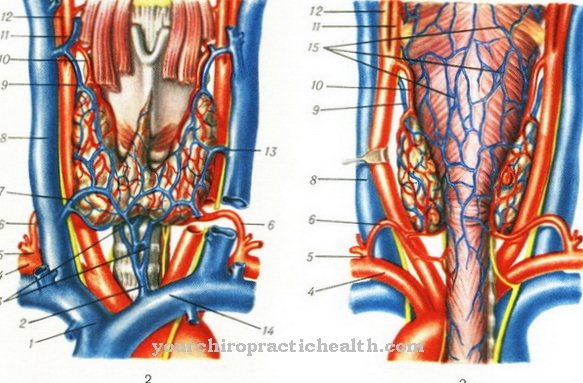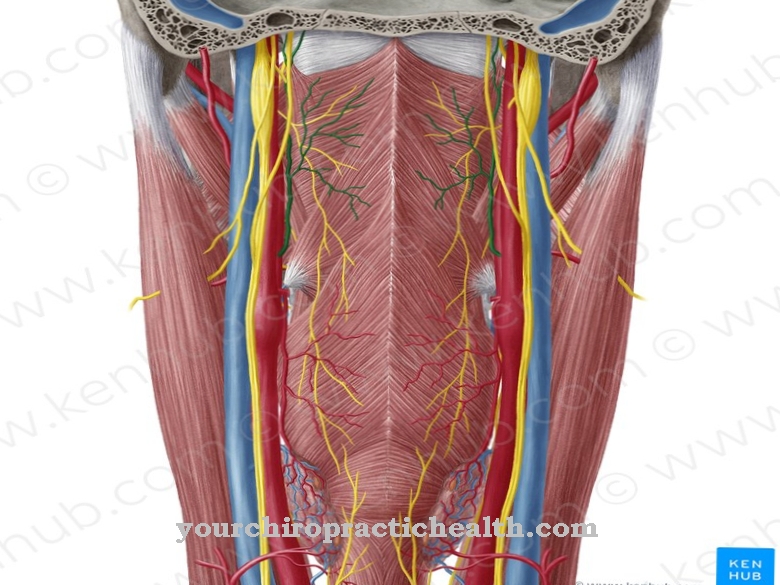In the Basilar artery it is an artery in the human brain. Their origin lies at the junction of the left and right vertebral arteries. Basically, the basilar artery is one of the arteries responsible for supplying the brain with oxygenated blood. A serious disease that is sometimes associated with the vertebral artery is thrombosis in the artery.
What is the basilar artery?
The basilar artery forms in the area between the pons and the medulla oblongata. Here the vertebral arteries unite near the clivus at the base of the skull. The basilar artery then runs through the basilar sulcus in the area of the pons and travels through an enlarged area of the subarachnoid space.
This is the cisterna pontis. In the anterior area of the pons, the basilar artery is divided into two further arteries, namely the posterior cerebral artery. Before the artery forks, the arteriae cerebelli superiores branch off from the trunk vessel. Overall, the length of the artery is only three to three and a half centimeters. Basically, the basilar artery has three branches. These are the anterior inferior cerebellar artery, the superior cerebellar artery and the pontis artery. In some cases, the labyrinthine artery also has its origin in the basilar artery.
Anatomy & structure
The entire supply area of the basilar artery is also sometimes referred to as the 'vertebrobasilar flow area'. The average length of the artery is about three centimeters, while its diameter is about three millimeters. The basilar artery runs through the pontis cistern in a rostral direction.
The artery is located in the so-called basilar sulcus. This area is formed by special elevations on the so-called pyramid tracks. Eventually the artery divides into the two posterior cerebral arteries. In the later course of the artery, the arteriae inferiores anteriores cerebelli, which supplies the cerebellum, and the arteriae superiores cerebelli split off. In addition, the artery also contributes to the supply of the arteria labyrinthi. In numerous cases, however, this arises from the inferior anterior cerebellar artery and supplies the inner ear.
Function & tasks
The basilar artery plays an important role in supplying the brain with blood. In its course, the artery divides into various small branches, which in turn supply other areas of the brain with blood. Here, primarily oxygen-rich blood is transported, which is essential for the functioning of the human brain. Disruptions in the blood supply and the course of the basilar artery can have serious or fatal consequences for the person concerned.
In addition, the artery is also responsible for supplying certain parts of the pons and the medulla oblongata. For this purpose, the basilar artery has a large number of small branches and branches, the so-called rami ad pontem or arteriae pontis. These branches are divided in terms of their supply points. The medial ramifications are primarily responsible for the blood supply to the arteries in the surrounding areas of the pons.
Diseases
Various ailments and diseases are possible in connection with the basilar artery. Circulatory disorders in the basilar artery supply area are mainly expressed in the form of complaints such as dizziness and noises in the ears.
These symptoms arise primarily from the fact that the inner ear and areas of the vestibulocochlear nerve are no longer adequately supplied with blood and oxygen. In addition, disturbances of the sense of balance and symptoms of paralysis as well as paresthesia are possible. In many cases, however, the symptoms are limited to half of the body, as only a few branches of the basilar artery are often affected.
A particularly serious disease is a thrombosis of the basilar artery. This is a life-threatening condition, as it can lead to a brainstem infarction. As a result, symptoms such as paralyzed limbs, disorders of sensitivity, and swallowing and breathing disorders appear. In the case of a particularly severe brainstem infarction, the head, trunk and limbs are completely motionless. Only the eyes can be moved arbitrarily in the vertical direction. A basilar thrombosis occurs when the basilar artery closes with a thrombus. The reasons for this are often degenerative changes in the artery or an embolism.
In addition to nausea, vomiting and dizziness, the affected patients usually also suffer from various neurological symptoms. These include, for example, speech disorders, impaired consciousness, nystagmus or ataxia. The basilar artery thrombosis is diagnosed using an MRI scan. Special contrast media are used for this. Basically, the prognosis for a thrombosis of the basilar artery is relatively poor. The faster the thrombosis therapy is started, the greater the chances of survival. Without adequate treatment, basilar thrombosis has a mortality rate of over 90 percent. Thrombolysis is available as the therapeutic measure of first choice. This is performed locally using a microcatheter or systemically.
In principle, a basilar artery thrombosis is an urgent emergency that requires immediate medical attention. Therefore, a doctor or an emergency doctor should be consulted as soon as possible if the first symptoms of the disease occur.













.jpg)

.jpg)
.jpg)











.jpg)